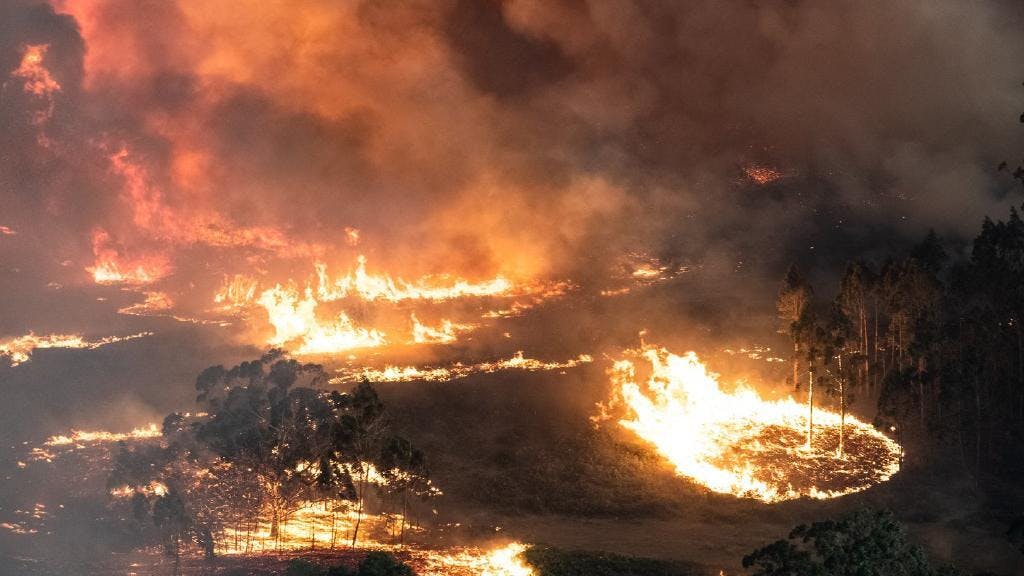Australia's profit-driven apocalypse

Some firefighters report flames 150 metres high. Read that again, slowly. Flames 150 metres high. Higher than a 40 storey building.
This is Australia’s new summer normal. Towering flames and terrified humans, huddling on the beach in the dark night or the orange glow of day. Shambolic, panicked, thousands forced to flee. Cities and towns shrouded for days and weeks and now months in a smoke haze that ranges from irritating, to toxic, to deadly. An area burnt that reportedly dwarfs the land affected by both the Amazon and California fires.
Dozens are dead or missing. And it is still early days.
Melbourne’s Age newspaper reports on the evacuation of Corryong, in Victoria’s northeast, on new year’s eve: “Anyone who wanted to join the convoy needed enough fuel to make it to Tallangatta, about 85 kilometres away, and write their names on a list. The list would be for the coroner if it all went wrong.”
The flames cast a searing light over the priorities of Australia’s rulers.
We see firefighters making do with pathetic paper masks, while the government gifts $12 billion every year to fossil fuel companies ($29 billion if you count indirect subsidies).
We see a military which can mobilise massive force to defend oil and empire in the Middle East, and to capture refugees from those wars and deliver them to an island prison – but is apparently incapable of moving a civilian population to safety with anything approaching urgency.
We see a political and economic elite that can’t wrench itself away from the industries that have created this disaster. Six of the 30 biggest corporations on Australia’s stock exchange are mining or fossil fuel companies – probably a world record. Coal is 15 percent of export revenues. Australia’s ruling class is one of the most carbon-addicted sections of a global elite that has always valued power and profit above our planet and our lives.
We see the political expression of this economic interest: one wing of the political establishment (the Liberals and Nationals) can’t admit that this catastrophe is anything to do with climate change. The other wing of the political establishment (Labor and some “dissident” Liberals) will tut tut about climate change – while opening up vast new tracts of the country to the fossil fuel and mining industries.
We see the Murdoch-owned media going into overdrive with lies about fuel loads. The truth is that these fires are the predicatable – in fact, the actually predicted – consequence of climate change. For more than a decade, we’ve seen the cool wet weather fronts that once brought winter rain to southern Australia slip south, just as the science predicted. There is no guarantee that these rains will ever return with any regularity. Economist Ross Garnaut, himself no radical, notes that the watershed of the country’s greatest river system is heading for desertification and invites comparisons with the collapse of previous civilisations.
We see communities left with no support. One of the few Aboriginal communities to get any coverage in the media is Lake Tyers, in Gippsland, where a small tank on a ute is the only firefighting equipment available to the community. Meanwhile Prime Minister Scott Morrison’s new plane cost a reported $250 million.
We see party after party at Kirribilli House while the country burns and Sydney chokes. In the desperate search for someone who will shake his hand, our fuckwit coal-fondling prime minister seeks refuge with the national cricket team.
In other words: we see Australian capitalism in all its obscene, coal-addicted glory.
Searching for words to describe the catastrophe, many survivors, firefighters and observers find one: apocalypse. And clearly it is – for the dead, for their loved ones, for the communities blasted by columns of fire and turned into columns of smoke.
But this isn’t the end of days. It’s not even the end of summer. There is plenty more of the country that will burn.
Anyone who listens to the radio would have for months heard farmers, small town mayors, truck drivers and all sorts, testifying that vast tracts of country down the east coast from Brisbane to Melbourne, dry for ten years, has had no significant rainfall for three years and is tinder dry, waiting to explode. Hopefully the meteorologists are right, that the late shift of the monsoon up north might bring some rain down south, later in January. Whether that will actually put the fires out, though, is anyone’s guess. What the rest of this summer, and the summers to come might bring doesn’t bear thought.
And this is before we hit the “tipping points” discussed by climate scientists; before Labor and Liberal’s Adani mine unleashes its profit-boosting load of poison into the atmosphere; before we hit the “runaway” part of the “runaway climate change” that Australia’s corporate elites profit so handsomely from fuelling; before Origin Energy’s fracking in the Northern Territory turns a profit; before BHP announces another world record profit on the back of its world-poisoning coal business.
Unlike the Biblical apocalypse, this seemingly unending fire season is no act of God. The most powerful people on Earth, and in Australia, have made choices that have led to this – specific choices in the interests of profit and power. And they won’t stop just because of the fires – not while there’s still profit to be made and political power to be held.
At a rally outside the International Mining and Resources Conference in Melbourne in October, a Chilean activist put it well: “They don’t care if people burn. They don’t care if the planet burns. They care only about their power. They will be the lords of the ashes.”
No saviour from on high will deliver us. The only path forward is to build a radical mass movement that can challenge and ultimately overthrow our rulers’ creed, their real religion, their alpha and their omega: their profits and their power.